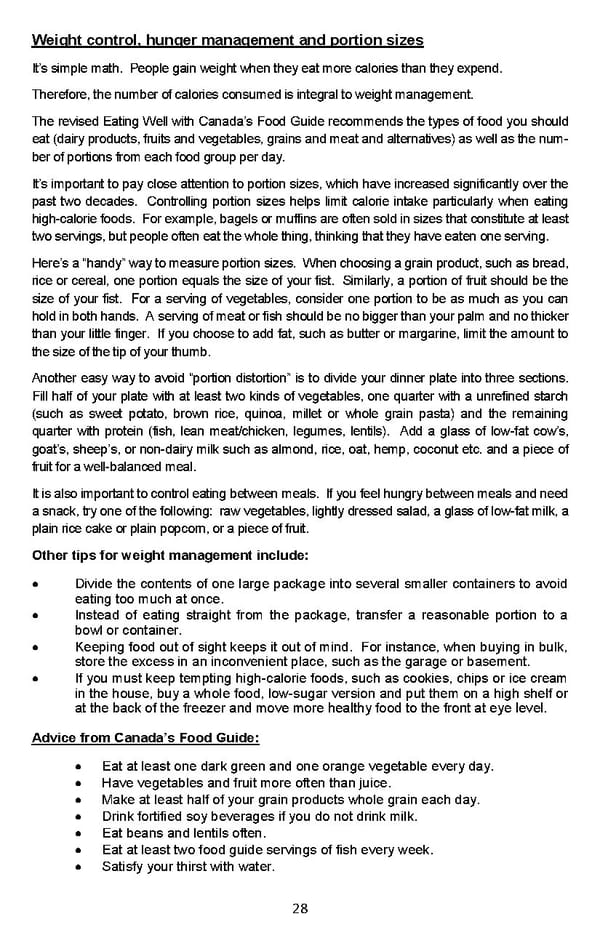Weight control, hunger management and portion sizes It’s simple math. People gain weight when they eat more calories than they expend. Therefore, the number of calories consumed is integral to weight management. The revised Eating Well with Canada’s Food Guide recommends the types of food you should eat (dairy products, fruits and vegetables, grains and meat and alternatives) as well as the num- ber of portions from each food group per day. It’s important to pay close attention to portion sizes, which have increased significantly over the past two decades. Controlling portion sizes helps limit calorie intake particularly when eating high-calorie foods. For example, bagels or muffins are often sold in sizes that constitute at least two servings, but people often eat the whole thing, thinking that they have eaten one serving. Here’s a “handy” way to measure portion sizes. When choosing a grain product, such as bread, rice or cereal, one portion equals the size of your fist. Similarly, a portion of fruit should be the size of your fist. For a serving of vegetables, consider one portion to be as much as you can hold in both hands. A serving of meat or fish should be no bigger than your palm and no thicker than your little finger. If you choose to add fat, such as butter or margarine, limit the amount to the size of the tip of your thumb. Another easy way to avoid “portion distortion” is to divide your dinner plate into three sections. Fill half of your plate with at least two kinds of vegetables, one quarter with a unrefined starch (such as sweet potato, brown rice, quinoa, millet or whole grain pasta) and the remaining quarter with protein (fish, lean meat/chicken, legumes, lentils). Add a glass of low-fat cow’s, goat’s, sheep’s, or non-dairy milk such as almond, rice, oat, hemp, coconut etc. and a piece of fruit for a well-balanced meal. It is also important to control eating between meals. If you feel hungry between meals and need a snack, try one of the following: raw vegetables, lightly dressed salad, a glass of low-fat milk, a plain rice cake or plain popcorn, or a piece of fruit. Other tips for weight management include: • Divide the contents of one large package into several smaller containers to avoid eating too much at once. • Instead of eating straight from the package, transfer a reasonable portion to a bowl or container. • Keeping food out of sight keeps it out of mind. For instance, when buying in bulk, store the excess in an inconvenient place, such as the garage or basement. • If you must keep tempting high-calorie foods, such as cookies, chips or ice cream in the house, buy a whole food, low-sugar version and put them on a high shelf or at the back of the freezer and move more healthy food to the front at eye level. Advice from Canada’s Food Guide: • Eat at least one dark green and one orange vegetable every day. • Have vegetables and fruit more often than juice. • Make at least half of your grain products whole grain each day. • Drink fortified soy beverages if you do not drink milk. • Eat beans and lentils often. • Eat at least two food guide servings of fish every week. • Satisfy your thirst with water. 28
 Living Well With Lupus Facts Booklet Page 27 Page 29
Living Well With Lupus Facts Booklet Page 27 Page 29